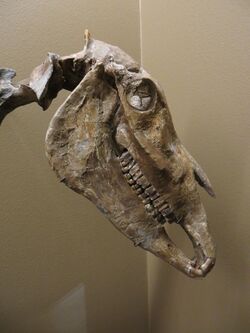Biology:Equus stenonis
| Equus stenonis | |
|---|---|

| |
| Scientific classification | |
| Domain: | Eukaryota |
| Kingdom: | Animalia |
| Phylum: | Chordata |
| Class: | Mammalia |
| Order: | Perissodactyla |
| Family: | Equidae |
| Genus: | Equus |
| Species: | †E. stenonis
|
| Binomial name | |
| †Equus stenonis Cocchi, 1867
| |
Equus stenonis is an extinct species of equine that lived in Western Eurasia during the Early Pleistocene epoch.
Description
Specimens of Equus stenonis varied considerably in body size. The feet are monodactyl, the head is large and elongated and has an undulated top profile in side-view, the nasal notch is deeply incised. The braincase is flexed downward and is relatively small. The teeth have a v-shaped linguaflexid separating the metaconid and metastylid, similar to other "stenonines". The limb bones are relatively large and robust. The metapodial bones of the foot are proportionally elongate and robust, with the central digit having a massive morphology, with a large v-shaped muscle scar.[1]
Distribution
Equus stenonis is known from remains found across Europe, from the Iberian Peninsula to Greece, as well as the Dmanisi site in Georgia, spanning part of the Early Pleistocene, the oldest remains dating to approximately 2.5 million years ago, while the youngest dates are uncertain, ranging from 1.8-.1.3 million years ago.[1]
Taxonomy
The species was first named in 1867, with the type specimen being IGF 560, a skull with a now lost (but preserved as a cast) associated mandible collected from Terranuova Bracciolini in Italy. Several subspecies have been named, including E. stenonis vireti, E. stenonis guthi, E. stenonis pueblensis, E. stenonis olivolanus and E. stenonis stenonis, which likely represent different ecomorphotypes adapted to varying local conditions.[1]
The African species Equus koobiforensis and E. oldowayensis are closely related to E. stenonis.[2] E. koobiforensis and E. stenonis have been proposed to be closely related to zebras.[1]
Barron-Ortiz et al. (2019) resurrect the genus Allohippus for Equus stenonis based on the results of their cladistic analysis regarding the interrelationships of the genus Equus,[3] though this was subsequently rejected by other authors.[1]
References
- ↑ 1.0 1.1 1.2 1.3 1.4 Cirilli, Omar; Saarinen, Juha; Pandolfi, Luca; Rook, Lorenzo; Bernor, Raymond L. (October 2021). "An updated review on Equus stenonis (Mammalia, Perissodactyla): New implications for the European early Pleistocene Equus taxonomy and paleoecology, and remarks on the Old World Equus evolution" (in en). Quaternary Science Reviews 269: 107155. doi:10.1016/j.quascirev.2021.107155. https://linkinghub.elsevier.com/retrieve/pii/S0277379121003620.
- ↑ Bernor, R.L.; Armour-Chelu, M.J.; Gilbert, H.; Kaiser, T.M.; Schulz, E. (2010). "Equidae". in Werdelin, L.. Cenozoic Mammals of Africa. Berkeley: University of California Press. pp. 685–721. ISBN 9780520257214.
- ↑ Barrón-Ortiz, Christina I.; Avilla, Leonardo S.; Jass, Christopher N.; Bravo-Cuevas, Víctor M.; Machado, Helena; Mothé, Dimila (2019-09-12). "What Is Equus? Reconciling Taxonomy and Phylogenetic Analyses". Frontiers in Ecology and Evolution 7. doi:10.3389/fevo.2019.00343.
Wikidata ☰ Q15411518 entry
 |

